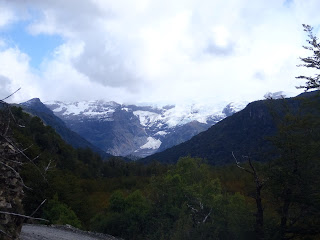This national park is one of several parks in Argentina's lake district, a beautiful and dynamic landscape of lakes, forests, mountains and glaciers. Bariloche is the main city in the lakes district, here around 100,000 people live on the banks of the enormous Lago Nahuel Huapi.
While Bariloche seemed like a nice enough place, we did not come here to see people and buildings. One night's rest after our arrival we obtained maps, food, water, propane gas and a vehicle and planned a rough travel route to explore the national park itself.
Our first real challenge was with the vehicle. In Argentina almost all cars, and undoubtedly all cars you can hire, have manual transmission. I have never driven a manual car before, and the last time Alix drove one was 15 years ago: when she had a few lessons. With an inspiring enthusiasm for adventure, Alix decided she would rise to the challenge and drive the manual car we hired on the steep, pothole-filled gravel roads winding through the mountains of the Parque Nacional.
Our first destination was Cascada Los Alerces, a crashing waterfall set between two lakes in a beautiful mountain forest. Our first camp site found us on a tiny knoll next to a rapid flowing river; resupply of fresh, sweet-tasting water was not going to pose a difficulty here.
In the morning, we visited the waterfall itself. Fortified by a sleep-in and a leisurely breakfast at our night camp five minutes away, we felt vastly superior to the tourists who waddled, bleary-eyed from their tour bus. After the soporific 2-hour bus ride from Bariloche they must have endured to reach the waterfall that morning, the tourists had ten minutes or so to take a photo and get back on the bus for another sleepy journey to their next postcard moment in an otherwise long, minibus-riding day. In our first vlog you can see the grumpy face of an unimpressed tourist in the background behind Alix.
From the Cascada we continued climbing up the mountain road to our main destination at Monte Tronador. Her top obscured by the autumnal clouds, this enormous spire is a deceased volcanic goddess, she is attended in death by seven retreating glaciers and a thin but spectacular waterfall with the awesome name "Garganta Del Diablo"- the Throat of the Devil.
Close to the base of the mountain inclement weather is no small matter. We quickly set up camp at Pampa Linda, the base camp of Mount Tronador before the temparature dropped to a few degrees celsius and the rain began a steady, unrelenting drizzle that lasted several days. Looking down on Pampa Linda from the lookout "Mirador De Valle" the next day, a brief break in the clouds cast a rainbow across the valley and brought out the local bird of prey- a small falcon named the chimango.
After a day's slog through the rain and wind in search of picturesque beauty that was drowned in the wet we left Mt Tronador cold, hungry, damp and satisfied, in search of a warm bed and some well deserved hot food.
In retrospect, our decision to camp out in the mountains in April was driven more by ignorance than bravery, more by our desire to extend beyond minibus tourism than by a true appreciation of the conditions we would encounter. What we did learn in the majesty of the mountains is that Monte Tronador is a sleeping beauty who is not to be visited whimsically.









No comments:
Post a Comment